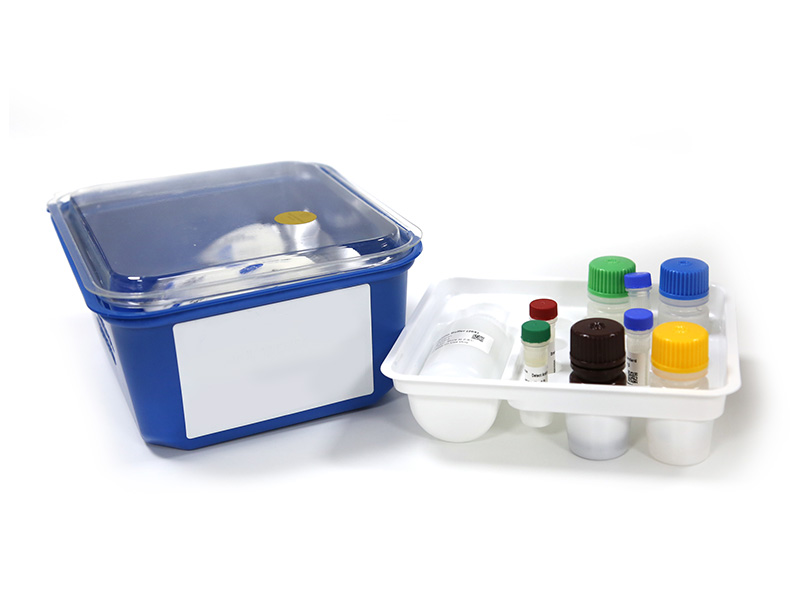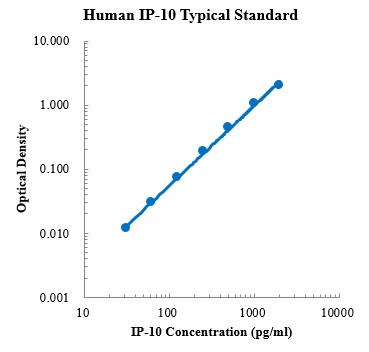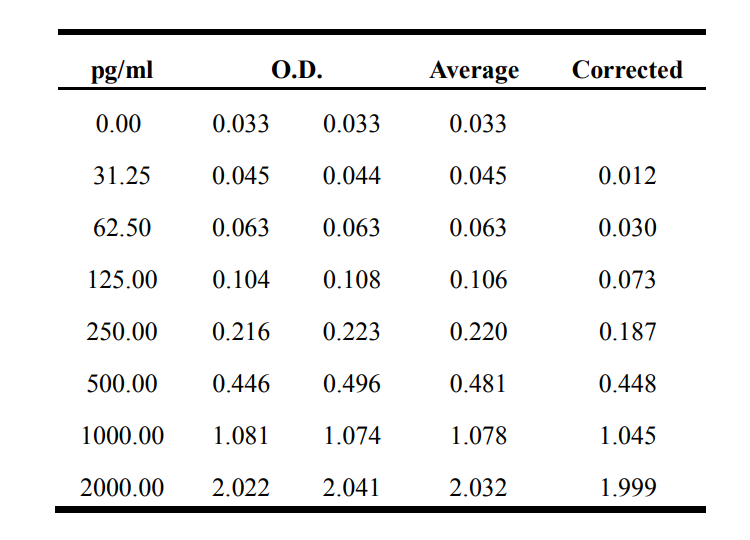
Human CXCL10/IP-10 ELISA Kit
$350.00 – $450.00
| Sample Type | Serum, plasma, cell culture supernatant, and other biological samples |
|---|---|
| Sample Volume | 50 μL |
| Sensitivity | 3.50 pg/mL |
| Range | 31.25 pg/mL – 2000 pg/mL |
| Assay Time | 3.5 h |
| Recovery | 78% – 114% |
| Average Recovery | 0.93 |
| Intra Precision | 3.0% – 5.0% |
| Inter-Precision | 3.8% – 6.1% |
| Platform | ELISA |
| Plate | Detachable 96-well plate |
| Size | 96T/48T |
| Storage | If the reagent kit is unopened, it should be stored at 4℃. However, if it has been opened, the standard solution should be stored at -20℃, while the other components should be stored at 4℃. |
| Delivery | 4℃ blue ice transportation |
| Components | 96-well polystyrene enzyme-linked immunosorbent assay (ELISA) plate coated with anti-CXCL10/IP-10 monoclonal antibody Human CXCL10/IP-10 freeze-dried standard CXCL10/IP-10 detect Antibody Standard Diluent Assay Buffer(10×) Substrate TMB Stop Solution Washing Buffer(20×) Sealing Film |
| Assay Principle | This kit utilizes the double antibody sandwich enzyme-linked immunosorbent assay (ELISA) detection technique.Specific anti-human IP-10 antibodies are precoated on a high-affinity ELISA plate. Standard samples, test samples, and biotinylated detection antibodies are added to the wells of the ELISA plate. After incubation, IP-10 present in the samples binds to the solid-phase antibodies and the detection antibodies. After washing to remove unbound substances, streptavidin-HRP labeled with horseradish peroxidase is added. After washing, a colorimetric substrate, TMB, is added and the plate is incubated in the dark for color development. The intensity of the color reaction is directly proportional to the concentration of IP-10 in the samples. A stop solution is added to terminate the reaction, and the absorbance value is measured at a wavelength of 450 nm (with a reference wavelength range of 570-630 nm). |
Targets
CXCL10
CXCL10 Target Infomation Overview
- Target Symbol: CXCL10, C-X-C motif chemokine ligand 10
- Gene Groups: Chemokine ligands
- Alias: IFI10; IP-10; crg-2; mob-1; C7; gIP-10
- Previous Names: INP10; SCYB10
- Alias Names: small inducible cytokine subfamily B (Cys-X-Cys), member 10; chemokine (C-X-C motif) ligand 10
CXCL10, C-X-C motif chemokine ligand 10 Target Infomation by Species
[su_tabs][su_tab title=”Human” disabled=”no” anchor=”” url=”” target=”blank” class=”tab-human”]
Human CXCL10 Target Information
- Target Symbol: CXCL10, C-X-C motif chemokine ligand 10
- Alias:
- 10 kDa interferon gamma-induced protein
- C-X-C motif chemokine 10
- C7
- chemokine (C-X-C motif) ligand 10
- crg-2
- gamma IP10
- gamma-IP10
- gIP-10
- IFI10
- INP10
- interferon-inducible cytokine IP-10
- IP-10
- mob-1
- protein 10 from interferon (gamma)-induced cell line
- SCYB10
- small inducible cytokine subfamily B (Cys-X-Cys), member 10
- small-inducible cytokine B10
- NCBI_Gene: 3627
- UniProtKB: P02778
Human CXCL10 Predicted Functions
Enables chemoattractant activity; chemokine receptor binding activity; and heparin binding activity. Involved in several processes, including positive regulation of release of sequestered calcium ion into cytosol; regulation of leukocyte chemotaxis; and response to virus. Acts upstream of or within cellular response to lipopolysaccharide and positive regulation of T cell migration. Located in extracellular region. Implicated in hepatitis B and middle cerebral artery infarction. Biomarker of several diseases, including artery disease (multiple); diabetes mellitus (multiple); fatty liver disease (multiple); liver disease (multiple); and lung disease (multiple).
[/su_tab]
[su_tab title=”Mouse” disabled=”no” anchor=”” url=”” target=”blank” class=”tab-mouse”]
Mouse Cxcl10 Target Information
- Target Symbol: Cxcl10, chemokine (C-X-C motif) ligand 10
- Alias:
- C7
- CRG-2
- gIP-10
- Ifi10
- INP10
- interferon activated gene 10
- IP-10
- IP10
- mob-1
- Scyb10
- small inducible cytokine B subfamily (Cys-X-Cys), member 10
- NCBI_Gene: 15945
Mouse Cxcl10 Predicted Functions
Predicted to enable chemoattractant activity; chemokine receptor binding activity; and heparin binding activity. Acts upstream of or within several processes, including defense response to virus; negative regulation of myoblast differentiation; and negative regulation of myoblast fusion. Located in external side of plasma membrane and extracellular space. Is expressed in several structures, including alimentary system; axial skeleton; hemolymphoid system; and liver. Human ortholog(s) of this gene implicated in hepatitis B; middle cerebral artery infarction; and type 1 diabetes mellitus. Orthologous to human CXCL10 (C-X-C motif chemokine ligand 10).
[/su_tab]
[su_tab title=”Rat” disabled=”no” anchor=”” url=”” target=”blank” class=”tab-rat”]
Rat Cxcl10 Target Information
- Target Symbol: Cxcl10, C-X-C motif chemokine ligand 10
- Alias:
- 10 kDa interferon gamma-induced protein
- C-X-C motif chemokine 10
- chemokine (C-X-C motif) ligand 10
- gamma-IP10
- interferon-inducible cytokine IP-10
- interferon-inducible protein 10
- IP-10
- protein Mob-1
- Scyb10
- small inducible cytokine B subfamily (Cys-X-Cys) member 10
- small inducible cytokine B subfamily (Cys-X-Cys), member 10
- small-inducible cytokine B10
- NCBI_Gene: 245920
- UniProtKB: P48973
Rat Cxcl10 Predicted Functions
Enables chemokine activity. Involved in several processes, including response to auditory stimulus; response to gamma radiation; and response to vitamin D. Located in extracellular space. Used to study adult respiratory distress syndrome; myocarditis; proteinuria; renovascular hypertension; and type 1 diabetes mellitus. Biomarker of brain ischemia; encephalitis; and uveitis. Human ortholog(s) of this gene implicated in hepatitis B and middle cerebral artery infarction. Orthologous to human CXCL10 (C-X-C motif chemokine ligand 10).
[/su_tab][/su_tabs]
CXCL10 Target News
[catlist tags=”cxcl10″ template=targetnews thumbnail=yes thumbnail_class=”related-post-media clr” thumbnail_size=833]





